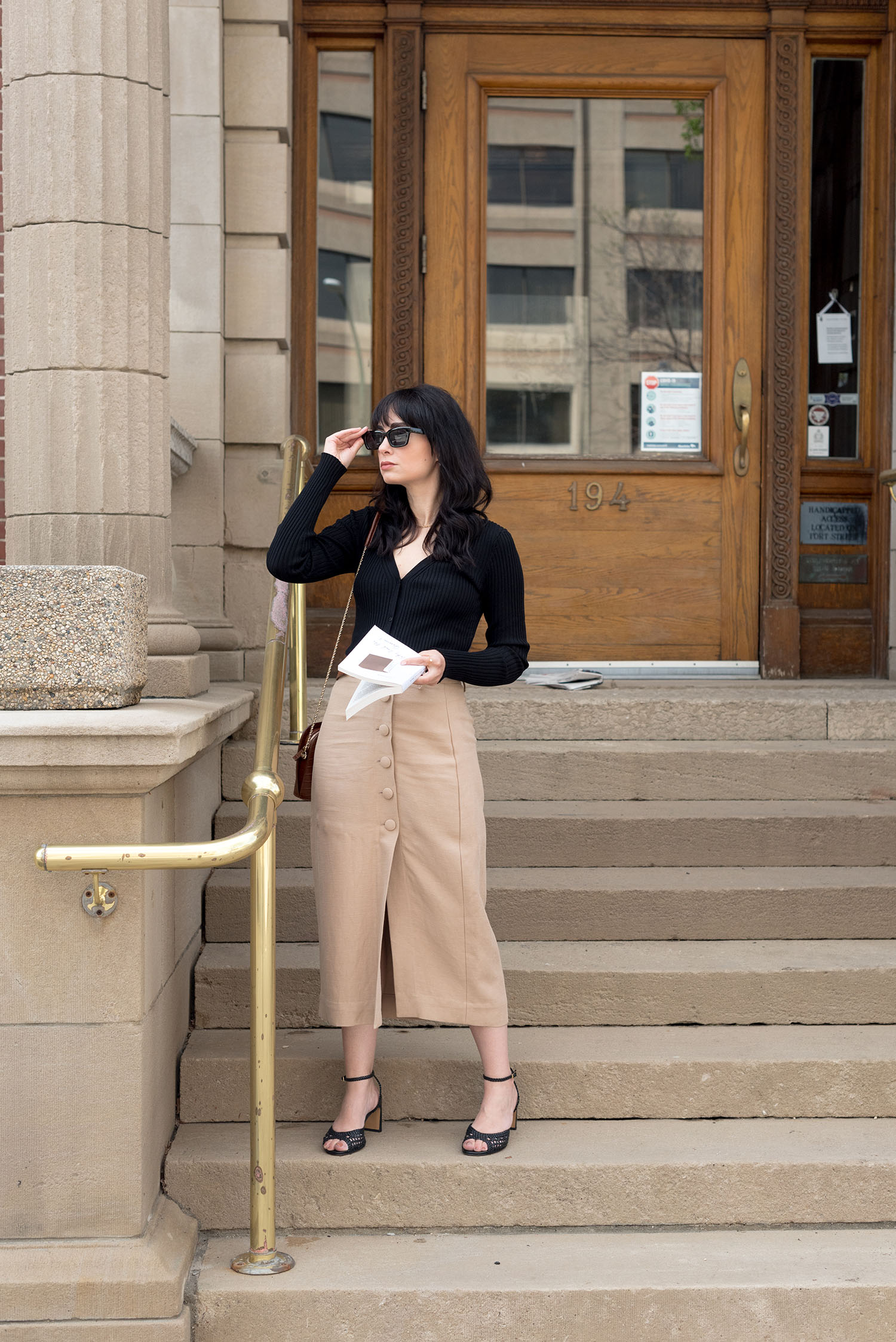
& Other Stories skirt
Rouje sandals (similar)
Sezane handbag
Vintage belt (similar)
Mango sunglasses
Stella & Dot necklace
Linjer ring (c/o) (similar)
Mejuri earrings (c/o) (similar)
Location: The Manitoba Club – Winnipeg, Manitoba
In 1919, Winnipeg was the third largest city in Canada. This seems hard to believe now, but it’s true. And on May 15th of that year, thirty-thousand workers went on strike. They brought the city economy to a standstill. The strike lasted six weeks, and remains one of the most influential labour events in Canadian history. In 2019, the city erected a monument to its most iconic moment; a monument to the day that striking workers toppled a streetcar, climbed in through its windows, which they broke, and set it on fire.
This is important because, while destructive, it was a defining moment for striking workers who believed in their worth. I don’t know how the public reacted at the time, but in the hundred years since, their act of defiance has been celebrated and memorialised.
Like many Manitobans, I had family members on both sides of the picket line during that strike. Those six weeks were, in many ways, a great equalizer for the Caucasian population of the province. This is important for so many reasons but mostly because we were all immigrants to this country and to Manitoba at the time, many of us very new immigrants. Fifteen years earlier, we, still officially citizens of a British colony, commissioned a statue in posthumous honour of Queen Victoria, the matriarch who made our life on this pilfered land possible.
And that is significant because, a little over a hundred years later, on July 1st, the day we traditionally celebrate as our nation’s birthday, the original owners of this land pulled Queen Victoria down off her stone pedestal. In the days since, I’ve heard the act described as destructive. The hypocrisy of this statement baffles me. What is setting out to sea for new lands, taking them over as your own and shamelessly killing the indigenous people of those lands to make space for yourself to spread out, if not destructive? And how can we consider toppling a hundred-year-old memorial to the woman who made those acts possible, particularly in a place the celebrates the same actions in the name of the labour movement, remotely comparable?
Queen Victoria’s legacy in Winnipeg, and Manitoba, is nothing to take pride in. We continue to dig up the bodies of children in unmarked graves on the grounds of former residential schools. Between 1893 and 1996, 150,000 Indigenous children were sent to residential schools. Approximately one in every fifty of those children died, abused, neglected or both. We should, reasonably, have known that they were buried on the grounds of their former prisons, but until this year, we chose not to dig. We did not value them enough to look for them. That attitude, which still pervades our society, is not worthy of memorialisation or celebration.
Anyone who calls the toppling of a statue destructive needs to take a long look in the mirror and ask themselves, how have I benefited from the destruction that built Canada? How do I continue to benefit from life in a country whose social constructs are designed for my personal gain at the expense of others? And if the shoe were on the other foot, what would I do? If I were the one being persecuted, how much tolerance would I show?
If you can already look at these events through a lens of understanding and compassion, I urge you not to stay silent. Voices of dissent are necessary. After all, it wasn’t just strikers who toppled that streetcar – their supporters helped them. We have an opportunity now to do the same, albeit figuratively.
The way I see it, the fact that in a hundred years, all that’s been toppled is a statue is a testament to incredible restraint on the part of Indigenous Canadians. I hope someday, sooner than a hundred years from now, we recognise that as worthy of celebration. We erected a monument to the destruction of a streetcar in the name of worker’s rights. We can surely find it within ourselves to recognise, and celebrate, the value of the people who continue to tolerate our presence in their homeland, largely giving us patience, understanding and friendship in exchange for whatever we deign to offer them.
I, unfortunately, literally had to have a conversation with a family member over the weekend wherein I had to forcefully and repeatedly tell them that, as someone with an advanced degree in history I acquired absolutely none of my knowledge from looking at a statue and that, actually, the true learning of history comes from listening to the debates and the rethinking of taken-for-granteds that we’re engaging in now. Their expectation as they entered into that conversation with me was that, as a historian of Britain, I would be appalled by the destruction of a statue of Queen Victoria … which, no.
Courtney ~ Sartorial Sidelines